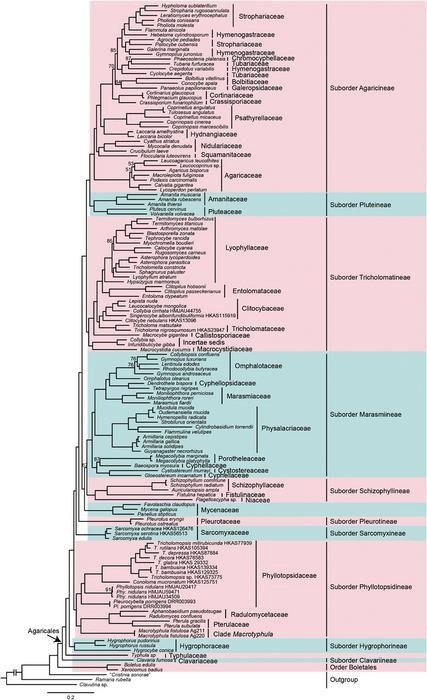The order Agaricales includes many of the edible, toxic, and medicinal mushrooms that are familiar to us.
 The Agaricales was divided into 10 suborders. Phyllotopsidineae and Sarcomyxineae are proposed as new suborders in this study. Image Credit: Geng-Shen Wang, Kunming Institute of Botany, Chinese Academy of Sciences
The Agaricales was divided into 10 suborders. Phyllotopsidineae and Sarcomyxineae are proposed as new suborders in this study. Image Credit: Geng-Shen Wang, Kunming Institute of Botany, Chinese Academy of Sciences
Fungi of this class have significant ecological and economic importance. Acquiring knowledge of the phylogenetic relationships among Agaricales can aid in comprehending their evolutionary history, diversity, and interactions with other biota.
Furthermore, using the Agaricales phylogenetic framework to measure phylogenetic diversity and evaluate the significance and uniqueness of various species can serve as a foundation for biodiversity conservation.
Agaricales was previously classified into 46 families and 8 suborders, however, it was unclear how certain genera and species fit into the overall system and how the genera and species related to one another phylogenetically. For instance, the genera Sarcomyxa and Tricholomopsis have long been contentious.
The Kunming Institute of Botany, Chinese Academy of Sciences research group on fungal diversity and molecular evolution worked with colleagues both domestically and abroad to perform genome skimming of fungal specimens from the genera Tricholomopsis, Sarcomyxa, Macrotyphula, Phyllotopsis, and other related groups.
The collected data was combined with publicly available genomes of some other Agaricales species from databases. Using a variety of analytical techniques, including the construction of phylogenetic trees, gene conflict detection, single-copy orthologous gene extraction, and topology structure testing, based on the amino acid sequences of 555 single-copy orthologous genes, the scientists reconstructed the most robust and resolved phylogenetic framework of Agaricales, elucidating the systematic positions of Tricholomopsis and Sarcomyxa as well as the phylogenetic relationships among suborders.
The scientists altered the members of a few suborders and suggested a new Agaricales classification scheme with ten suborders.
In addition, the scientists officially published two new suborders (Phyllotopsidineae and Sarcomyxineae), one new genus (Conoloma), two new sections, six new species, and resolved numerous issues with the Chinese classification of Tricholomopsis. The scientists also talked about this genus’s preference for substrates and the evolution of the cap surface scale.
It has important scientific significance for further understanding the phylogenetic relationships among the major groups of Agaricales.”
Geng-Shen Wang, Key Laboratory for Plant Diversity and Biogeography of East Asia, Kunming Institute of Botany Chinese Academy of Sciences
Source:
Journal reference:
Wang, G., et al. (2023).Phylogenetic and taxonomic updates of Agaricales, with an emphasis on Tricholomopsis. Mycology - An International Journal on Fungal Biology.doi.org/10.1080/21501203.2023.2263031